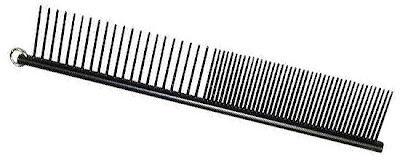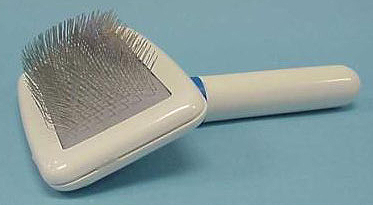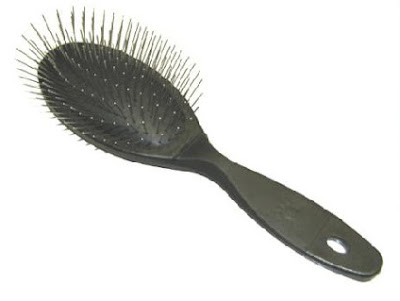This is a series of articles compiled from my own thoughts and a number of interviews I conducted with breeders, exhibitors, and owners of Clumbers from around the world. The article series is four parts, and has the following format:
Brushing (Clumbers June 2010)
Washing (Clumbers September 2010)
Trimming (Clumbers December 2010)
Skin issues and coat health (Clumbers March 2011)
There is a wealth of new information and some owners have also supplied fabulous new photos to illustrate points. The emphasis is on show and competition preparation, but the Clumber with a easy care coat can always be easily enough maintained at this level. In fact, this is more than likely the form which attracted you to the breed, so breeders and yourself should continue to strive to produce pups that can easily be presented in this fashion – ie with easily cared for coats that non-competition owners can maintain themselves.
Taking a bit more interest in coat preparation because I have had one or two dogs with less than ideal coats I have been chatting to suppliers of preparation. Some say, never brush a dry (non-dampened, or unwetted) coat, some say only ever brush a dry coat. Hmm, that made me wonder. Personally, overall I prefer to brush a dry coat, in fact, surely that is more in line with the 100 brush strokes of the young girl’s hair.
Climate does play a big factor in one’s choice of tools, Lynn Durrington in Queensland, Australia doesn’t have to worry about snow either, but has heat and humidity much of the year, “I brush a dry coat with a large soft slicker brush and use a wide toothed comb to go through the coat initially, followed by a finer toothed comb to ensure there are no tiny tangles.(I am also told by many exhibitors that Plush Puppy OMG is brilliant for bad tangles, but I have not yet needed to
try it)
“I apply Plush Puppy Protein Creme conditioner to the ends of all feathering or any other areas if needed.
“I only ever use a wide toothed comb or pin brush to groom a wet coat.”
Back up in the northern hemisphere and the United States, at the well known Nexus Kennels, James Fankhauser also willing shared his ‘secrets’ on brushing, “I seldom use a brush on the dogs. I prefer about a 5� chrome plated comb, one with wide teeth and one with medium width teeth. I came across some combs with comfortable rubber handles on them. My hands get sore quicker than they used to and the rubber handle helps keep the fatigue to a minimum.
“I will comb either a wet or a dry coat but I use a spray on conditioner if there are any tangles or mats in the coat or if the longer furnishings are a little drier. I originally bought a commercial spray conditioner but I have started using a gel type conditioner that I buy in the gallon size and I dilute that about 1 part conditioner to 6 parts warm water and use a spray bottle to apply it. This has worked really well for me and it is easy to apply and very economical.
“I try to get every dog on the grooming table for a good combing with in a two week cycle, so that amounts to trying to get about a dog per day combed out. I prefer to try and spread the work out instead of trying to do multiples in a day.” This rotation is essentially for anyone with a fair number of dogs at home, Jim’s comments on handlers brings to mind my recent thoughts on the same subject. The rake type comb outfit has been around for a long time, but I don’t find it ideal or even that much better for doing a big combing job then the standard slim back metal based combs or the extended into handle back combs, I wonder why there isn’t a moulded plastic slip on that would just ‘widen’ and shape the metal backs of the ‘greyhound’ combs – I have thought about, even decided an air dry modelling clay would make a fair prototype, but haven’t gone that far yet.
The extremely successful Danish kennel, Chervoods, brush their dry (non-wetted) coats each week with a wide tooth comb and a brush. Anne Ernst and Rita Frahm have also given me a translation of Karin Brostam’s excellent and comprehensive grooming article clumber.net which they recommend for illustrations on ‘how to’ and ‘what it should like’! Karin is part of the exceptional Swedish Dons Clumbers, now not as active as they have been in the past, they certainly present a healthy and neat Clumber. Karin recommends weekly brushing and points out that tangles/knots will most likely appear behind the ears, in the rear feathering at the back of the hind legs, between the hind legs, on the chest and between the front legs, so pay attention when combing and brushing to these areas in particular.

the “Greyhound comb: two tine spacings on a single back – this one is teflon coated, traditionally they are ‘silver’ with a chrome coating
I think I was lucky to secure Lee Cox’s input into this series, in fact his presentation of the interview is so lovely, I hope to find space to run it as a separate article one day! Lee grew up with the Maladetta Clumbers, and after a wealth of success with the Vanitonia Poodles and Chinese Crested Dogs, has found room in his dog life for Clumbers again in recent times, and has probably been the most successful Clumber exhibitor in recent years, this year he added Best of Breed at Crufts to his Clumber roll of honour which includes a number of championship group awards. Lee says “I never brush a dry coat as I believe that this does more harm than good. Far too much damage to the hair follicle occurs when the coat is dry. If a bath is completely out of the question and the coat needs attention, then I spray it before hand with a good quality grooming spray/ conditioner. This aids the grooming process and in turn protects the hair. However, if I am unlucky enough to have knots in the coat then my preferred method is to bath the dog and groom out the wet coat. Not only does this protect the hair as best as possible but it is far easier to remove any knots or tangles. Also as part of the drying process I will introduce a leave in conditioner on any longer hair.
Brushes are a very important part of the grooming process and I use the highest quality brushes that I can afford. I prefer to use brushes rather than combs as I feel that they are easier on the hair itself and therefore damage less. On the body coat I will use a soft slicker brush and on the furnishings a good quality pin brush.


photos courtesy Lee Cox
“Preferably the pins do not have bobbles on the end as this splits ends and eventually leads to coat loss. Combs are not good when knots are involved as although they remove the knot, they also remove far more hair than is necessary. However, if a comb is needed then the best, I find, is the old fashioned �greyhound� type of comb.”
Other great resources:
the Clumber Club of Canada’s article
the Williana Clumber Spaniel Club (USA) Instructional DVD www.williana.org
the Swedish Club source article clumber.net

